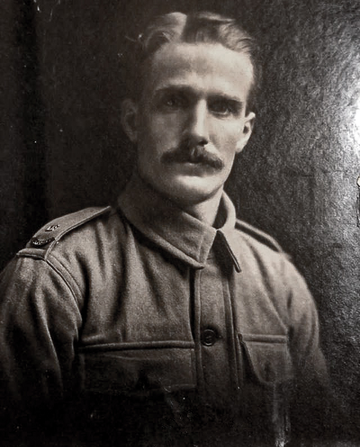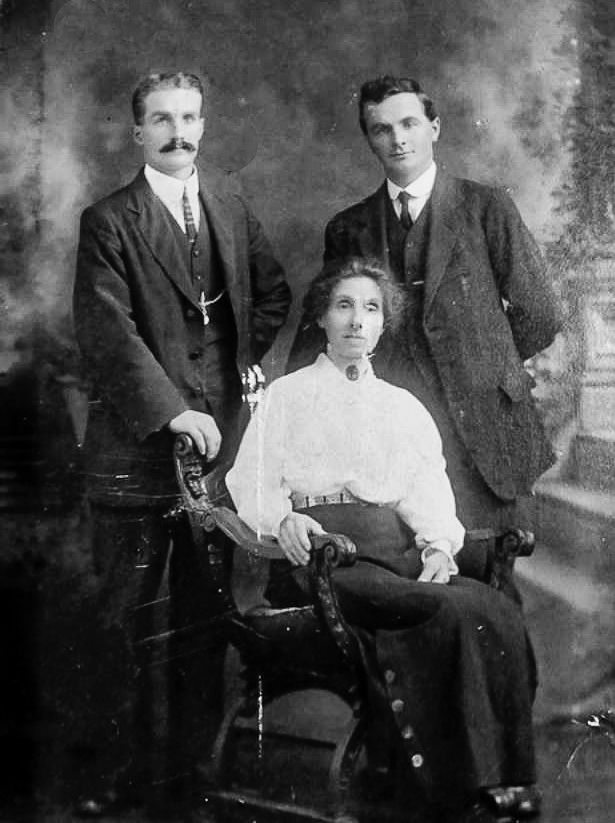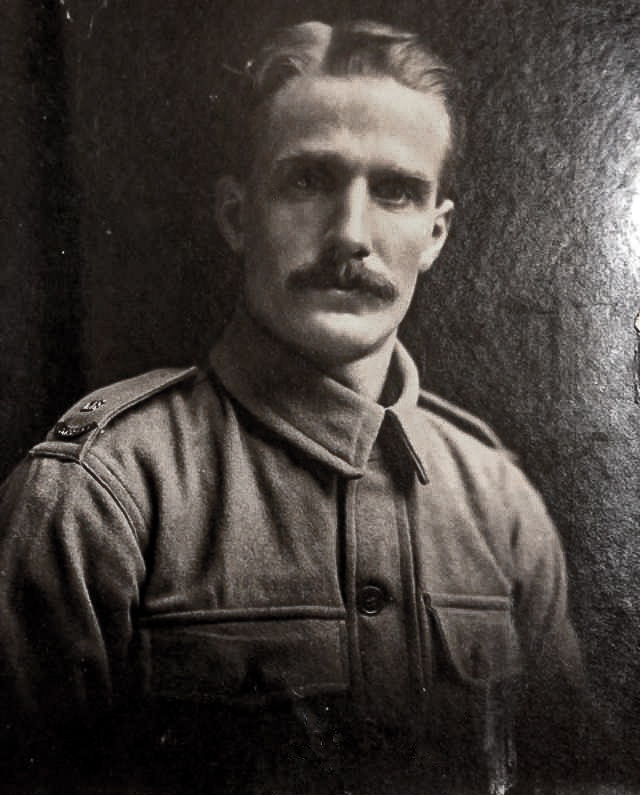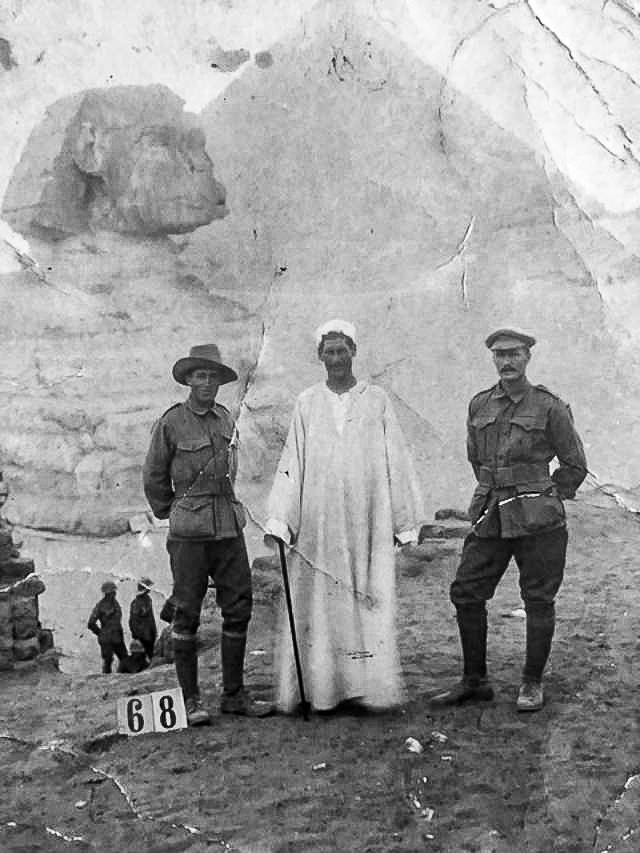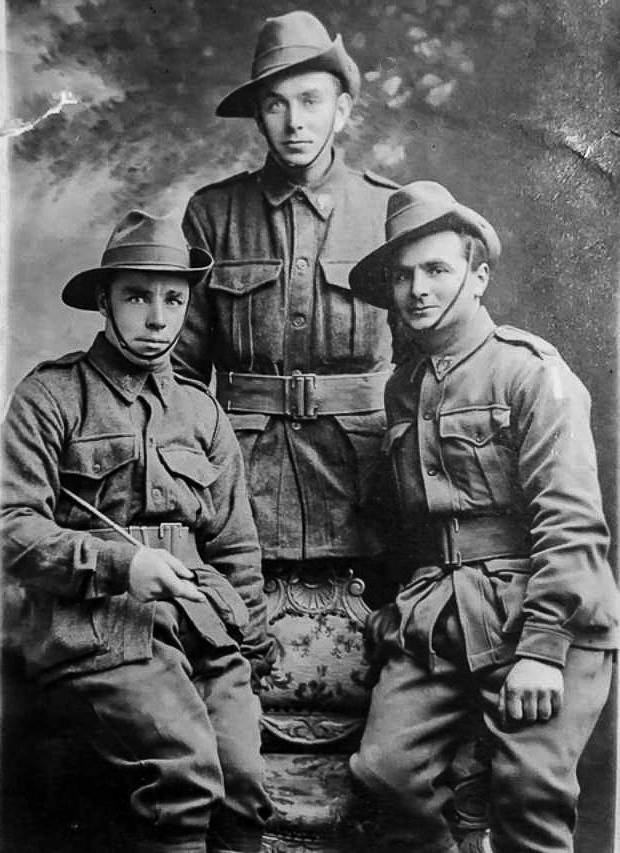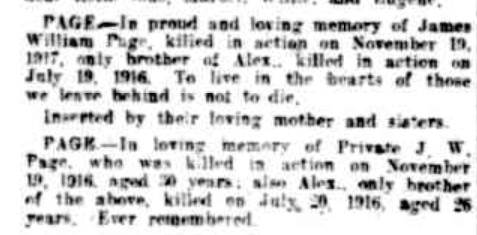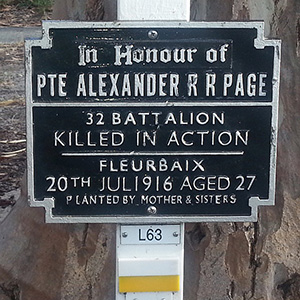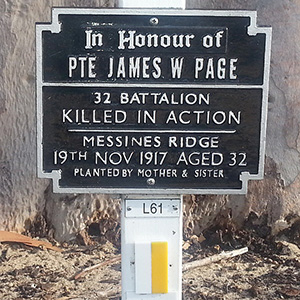Alexander Russell PAGE
Eyes blue, Hair fair, Complexion fair
Alexander Russell Robert Page
STOP PRESS 24 APRIL 2023
The minister has this day (24 April 2023) announced that Alexander has been identified as being buried in Pheasant Wood Cemetery
Our genealogical research is part of a collaborative effort with families, The Fromelles Project team of the Unrecovered War Casualties Section – Army and other interested folk. Without this spirit of co-operation, very few identifications could be made.
We wish to acknowledge and applaud our volunteer researchers who have worked many thousands of hours to achieve these, and so many other identifications.
At this time of great joy for those families of Fromelles soldiers just identified, and for our Association members, we are also thinking of the many, many families who hoped for an identification, but that has not occurred at this time.
Alexander Russell Robert Page, known as Alex, was born and raised in Bow, England and attended the Plough Road School and then the Church Farm Industrial School for Boys in East Barnet. The son of James William Page and Grace McKean, his father passed away in 1899 when Alex was just 10 years old. His mother briefly remarried before returning to her first married name (Page).
Alex had 5 known siblings:
- James (Jim) William 1887-1917 – Killed in action, Messine Ridge, Belgium
- Mary 1892-1985 married Sgt Edmund O’Brien 4867, 11th Battalion
- Eleanor (Ellen) 1892-1967 married David Fletcher
- Grace Jessie Winifred 1896-1997 married Pte John Henry William Penn, 16th Battalion
- Mabel Gladys 1899 – 1994 married Harry Campbell Morris
Alexander moved to Western Australia in 1911. Mother Grace and siblings - Jim, Mary, Ellen, Grace and Mabel - arrived in 1912 and settled in the Maylands area, living at 3 Gladstone Street. The two brothers were employed as milk carters.
Alex Off to War
Alex was the first of the Page brothers to enlist in July 1915. He was assigned to C company in the 32nd Battalion and, aged 27, began his training at the Blackboy Hill camp in Western Australia but was soon off to Adelaide.
The 32nd Battalion was formed at Mitcham, South Australia on 9 August 1915. A and B Companies were to be from South Australia while C and D from Western Australia. There was much fanfare about this, with gatherings, community support, such as the Cheer-up Society and reviews by the Premier. The men from WA arrived in Adelaide at the end of August and training for all continued there until they departed for Egypt on 18 November 1915 on the troop ship HMAT A2 Geelong .
As reported in The Adelaide Register:
“The 32nd Battalion went away with the determination to uphold the newborn prestige of Australian troops, and they were accorded a farewell which reflected the assurance of South Australians that that resolve would be realized.”
Egypt
The 32nd Battalion arrived in Suez on 14 December 1915 and settled into El Ferdan just before Christmas. They also marched to Ismalia, Tel El Kabir, Duntroon Plateau, Ferry Post and Moascar, continuing their training as they went.
While in Egypt, one soldier’s diary describes some of the food as “dog biscuits and beef” and that water was “scarce” on some of their long marches through the sands.
During their time in Egypt the 32nd had the honour of being inspected by H.R.H. Prince of Wales.
To the Western Front
After spending six months in Egypt, the call to support the British Expeditionary Force on the Western Front came in mid-June. They left from Alexandria on the ship Transylvania on 17th June and arrived at Marseilles, France on 23rd June 1916.
They then departed by train for the two-day trip to Hazebrouck, about 30 kilometres from Fleurbaix. Their route took them to a station just out of Paris, within sight of the Eiffel Tower, then through Bologne and Calais, with a view of the Channel, and finally headed to St Omer and Hazebrouck. Fellow soldier, Theodor Pflaum (No. 327) wrote about the trip in his diary:
“The people flocked out all along the line and cheered us as though we had the Kaiser as prisoner on board!!”
Wesley Choat (No. 68), for one, was glad to be out of Egypt, but he was well aware of what lay ahead:
“The change of scenery in La Belle France was like healing ointment to our sunbaked faces and dust filled eyes. It seemed a veritable paradise, and it was hard to realise that in this land of seeming peace and picturesque beauty, one of the most fearful wars of all time was raging in the ruthless and devastating manner of "Hun" frightfulness”.
The troops settled into nearby Morbecque and training continued with a focus on bayonets and the use of gas masks. D Company’s Lieutenant Sam Mills’ letters home were optimistic for the coming battle:
“We are not doing much work now, just enough to keep us fit—mostly route marching and helmet drill. We have our gas helmets and steel helmets, so we are prepared for anything. They are both very good, so a man is pretty safe.”
Battle of Fromelles
On 14 July they moved into Fleurbaix and were into the trenches on 16 July for the first time, only three weeks after arriving in France. On the 17th they were reconnoitering the trenches and cutting passages through the wires, preparing for an attack, but it was delayed due to the weather.
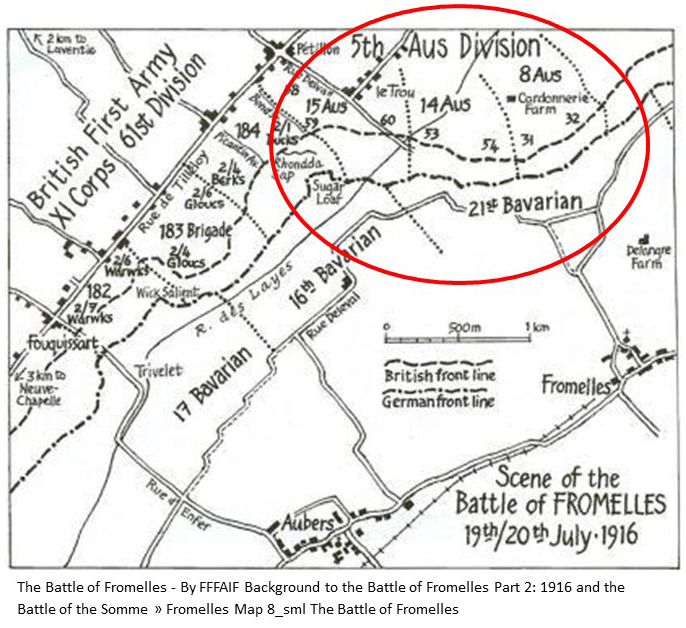
In the morning of the 18th, Alex’s C company together with A company went back into the trenches to relieve B and D companies. B and D rejoined on the 19th. All were in position by 5.45pm and the charge over the parapet began at 5:53pm. A and C companies were the first and second waves to go.
The 32nd was successful in the initial assaults and by 6.30pm were in control of the German’s 1st line system (map Trench B), which was described as “practically a ditch with from 1 to 2 feet of mud and slush at the bottom”.
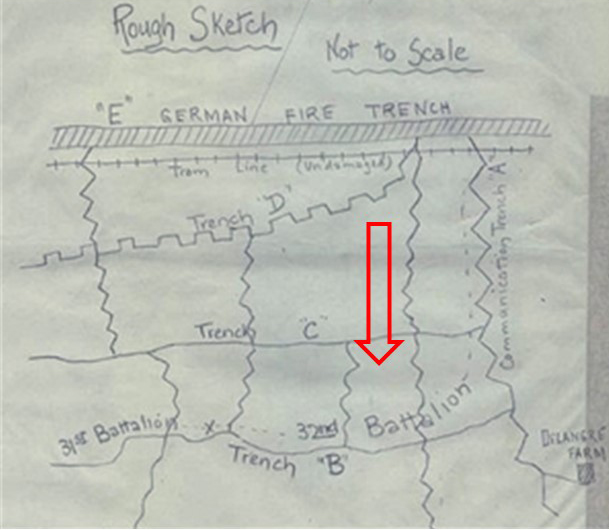
A charge at the Germans’ main line was made by the Australians from troops who had made it to Trench B. However, a lack of grenades and machine gun fire from an emplacement at Delangre Farm meant that they were unable to push the Germans back and had to retreat.
By 8.30pm their left flank had come under heavy bombardment with high explosives and shrapnel. Return bombardment support was provided and the troops were told that “the trenches were to be held at all costs”.
Fighting continued through the night. At 4:00am the Germans began an attack from the Australian’s left flank, bombing our troops and advancing into Trench A. Given the Australian advances that had been made earlier, the rear Trench E had been left almost empty, which then enabled the Germans to surround the soldiers of the 32nd.
Up ahead, the Australians made a further charge at the main German line beyond Trench B, but they were low on grenades, there was machine gun fire from behind from the emplacement at Delangre Farm and they were so far advanced that they were getting shelled by both sides.
A withdrawal was called, but they had to fight their way back through the Germans to get to their own lines. What was left of the 32nd had finally withdrawn by 7.30am on the 20th. The toll on the battalion was devastating – 718 casualties, 90% of their effective strength.
Lieutenant Sam Mills survived the battle. In his letters home, he recalls the bravery of the men:
“They came over the parapet like racehorses……… However, a man could ask nothing better, if he had to go, than to go in a charge like that, and they certainly did their job like heroes."
Like many from the 32nd Battalion, Alex was officially listed as missing in action.
The Page family back at home
In late August 1916, Grace was informed as next of kin that her younger son was missing in action and his name was amongst those in the long lists of casualties published in early September 1916.
By this time, older brother Jim had enlisted and was in training with the 32nd Battalion preparing for embarkation to Europe. Private 4104 James William Page left Australia with the 10th reinforcements, 32nd Battalion on 28 October 1916 leaving his mother and sisters awaiting news of Alex.
That news was not to arrive officially until after a court of enquiry, held in the field on the 12 August 1917, pronounced fate as 'Killed in Action, 20 July 1916'. The specific details of his death remain unknown with no eye-witness reports recorded. His Red Cross file shows that they made enquiries but without success.
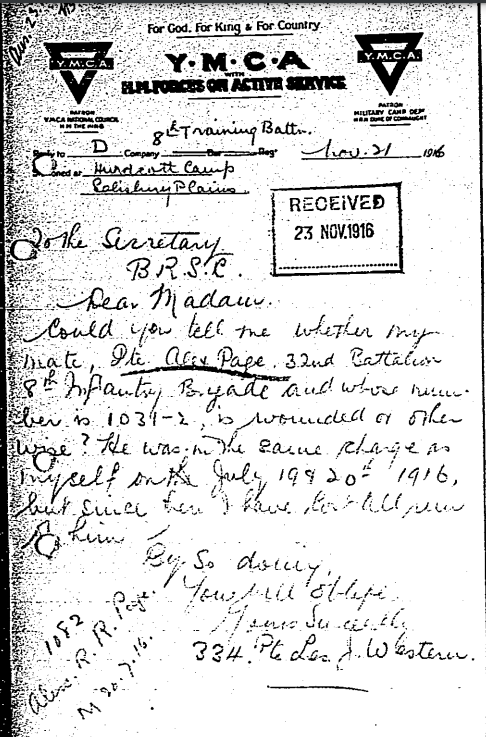
James William Page
Alex’s brother, 4104 Private James William Page enlisted in April 1916 arriving in Europe in October 1916 to join as reinforcement to his brother’s battalion, the 32nd. He continued training in camp in England before joining his unit in France in March 1917.
Jim served on the Western Front until he was killed in action at Messines Ridge on 19 November 1917, aged 30. According to evidence given to the Red Cross, Jim was wounded by a shell when sheltering in a pill box. The stretcher bearers who were treating him stated he was then struck by pieces of a second shell whilst on the stretcher.
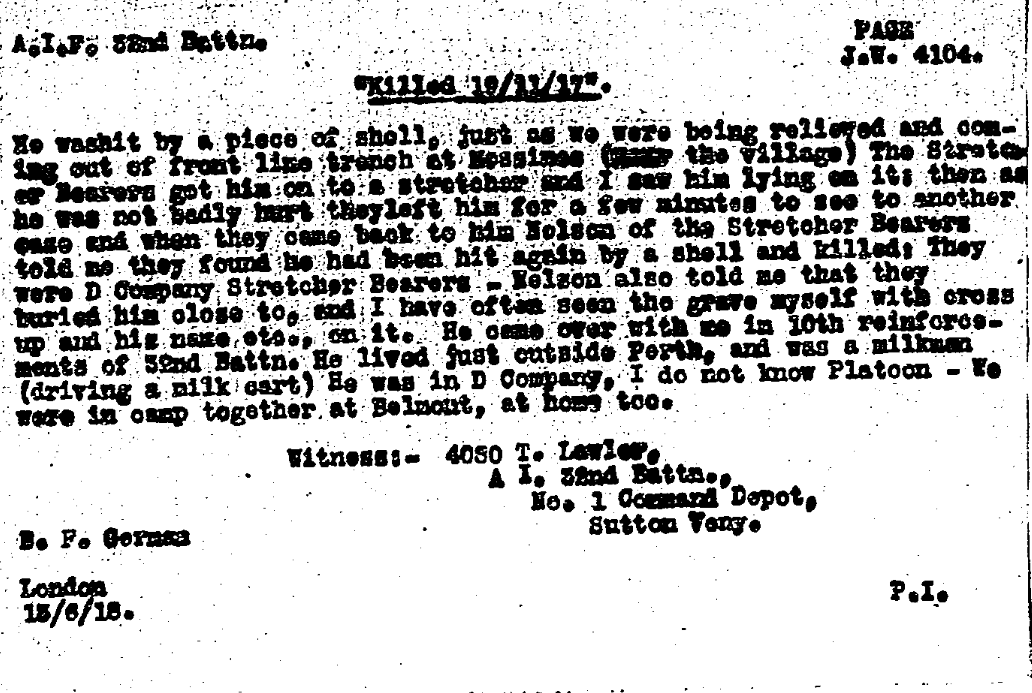
He was buried in a marked grave close by. However, in 1919 the War Graves Commission exhumed his remains and buried them in the Wulverghem-Lindenhoek Road Military Cemetery with the personal inscription:
Dead, yet still lives in the memory of those that loved him.
His identity disc was recovered in the process and returned to his mother.
Remembering Alex and Jim
So, three months after receiving official notification of Alex’s death, Grace was advised in December 1917 that she had lost a second son. We can only imagine the grief for Grace and her daughters. There were no personal effects found for either Jim or Alex to return to Grace though, as noted earlier, Jim’s identification disc was returned after he was re-buried in 1919. As next of kin, Grace received her two sons’ war service medals as well as their memorial plaques and scrolls.
In a July 1919 memorial notice, his family wrote:
“PAGE.—In loving memory of Alex R. R. Page, killed in action July 19, 1916; only brother of James W. Page killed in action on November 19 1917; both 32nd Battalion. It's hard to live without them. Inserted by his loving mother and sisters.”
And on November 19, 1919, they concluded their memorial notice for Alex and Jim with the words:
“Two of those who will stay behind when the boys come home.”
The Page family also honoured their two fallen sons and brothers by planting memorial trees for Alex and Jim in Kings Park in Perth, Western Australia in the 1930s.
While she mourned her sons, Grace had no opportunity to visit Alex’s grave as its whereabouts remained unknown in her lifetime but she had the rare privilege to visit Jim’s grave. Researchers believe that a trip in 1927 ten years after Jim’s death by Grace and two of her daughters (Mabel and Grace) included a visit to Jim’s graveside where a snapshot of Grace was taken.
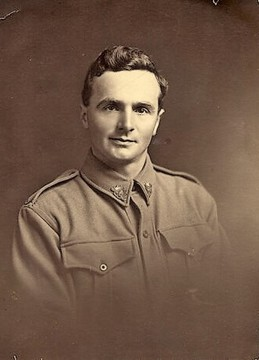
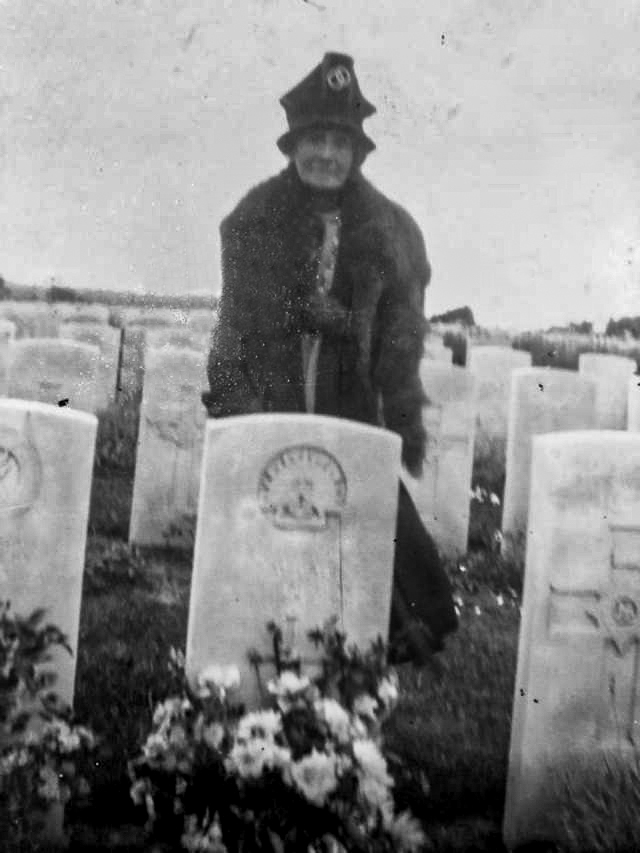
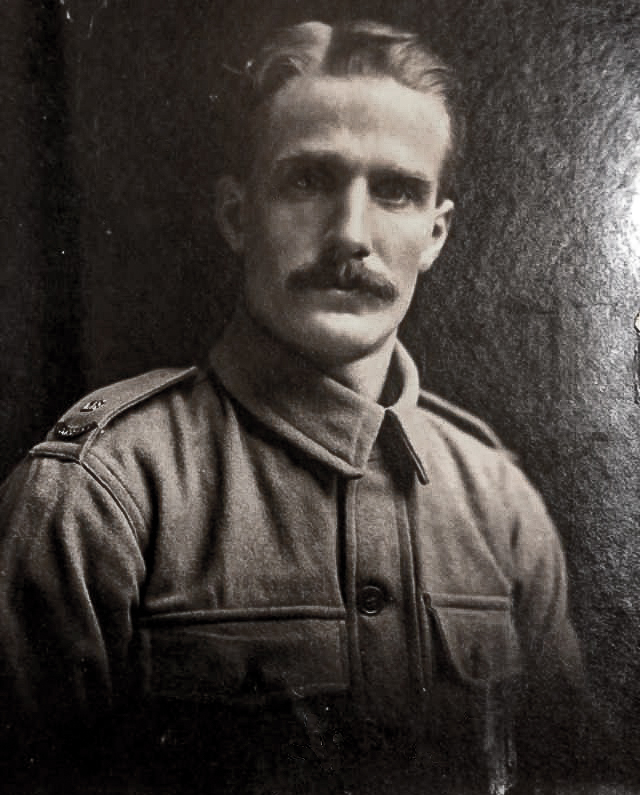
With Alex’s final resting place having been identified in April 2023, we now know that both brothers were buried and reinterred, and now can rest at last.
The Fromelles Association would love to hear from you

Contacts
(Contact: royce@fromelles.info or geoffrey@fromelles.info).
(Contact: army.uwc@defence.gov.au or phone 1800 019 090).
Donations
If you are able, please contribute to the upkeep of this resource.
(Contact: bill@fromelles.info ).
